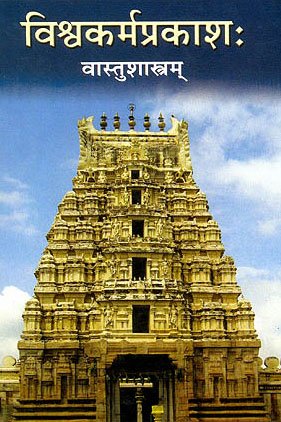Samsthapya, Saṃsthāpya: 6 definitions
Introduction:
Samsthapya means something in Hinduism, Sanskrit. If you want to know the exact meaning, history, etymology or English translation of this term then check out the descriptions on this page. Add your comment or reference to a book if you want to contribute to this summary article.
In Hinduism
Vastushastra (architecture)
Source: Brill: Śaivism and the Tantric Traditions (architecture)Saṃsthāpya (संस्थाप्य) refers to “establishing (mobile or fixed images) (in a temple)”, according to verse 4.243 of the Mohacūrottara (Mohacūḍottara), a Śaiva text from the 10th century.—Accordingly, “The reward that a wise man gains from establishing (saṃsthāpya) a mobile image [i.e. an ascetic] in a maṭha is the same as the reward that he gains from establishing (saṃsthāpya) a fixed image in a temple”.

Vastushastra (वास्तुशास्त्र, vāstuśāstra) refers to the ancient Indian science (shastra) of architecture (vastu), dealing with topics such architecture, sculpture, town-building, fort building and various other constructions. Vastu also deals with the philosophy of the architectural relation with the cosmic universe.
Purana and Itihasa (epic history)
Source: archive.org: Shiva Purana - English TranslationSaṃsthāpya (संस्थाप्य) refers to the “placing” (of the water-pot) (as part of a festival ceremony), according to the Śivapurāṇa 2.3.30 (“The Celebration of Pārvatī’s Return”).—Accordingly, as Brahmā narrated to Nārada: “On hearing that Pārvatī was returning, Menā and Himavat excessively delighted went ahead seated in a divine vehicle. [...] The auspicious water-pot was placed (saṃsthāpya) in the main highway decorated with sandal paste, aguru, musk and branches of trees with fruits. The priests, Brahmins and sages reciting the Vedas, dancing girls, all went ahead seated on lofty elephants to receive her. All round stumps of plantain trees were fixed. [...]”.

The Purana (पुराण, purāṇas) refers to Sanskrit literature preserving ancient India’s vast cultural history, including historical legends, religious ceremonies, various arts and sciences. The eighteen mahapuranas total over 400,000 shlokas (metrical couplets) and date to at least several centuries BCE.
Ganapatya (worship of Ganesha)
Source: archive.org: Shiva Purana - (Ganesha)Saṃsthāpya (संस्थाप्य) refers to the “placing (of a jar)” (during the worship of Gaṇeśa), according to the Śivapurāṇa 2.4.18 (“Gaṇeśa crowned as the chief of Gaṇas”).—Accordingly, as Śiva said to Gaṇeśa: “[...] Then the rites shall formally be dismissed. Then he shall remember Gaṇeśa. Thus the Vrata shall be concluded auspiciously. When thus the Vrata is duly completed in a year, the devotee shall perform the rite of formal dismissal for the completion of the Vrata. At my bidding twelve brahmins shall be fed. After placing (saṃsthāpya) a jar your image shall be worshipped. [...]”.
Ganapatya (गाणपत्य, gāṇapatya) represents a tradition of Hinduism where Ganesha is revered and worshipped as the prime deity (ishta-devata). Being a minor though influential movement, Ganapatya evovled, llike Shaktism and Shaivism, as a separate movement leaving behind a large body of literature.
Languages of India and abroad
Sanskrit dictionary
Source: Cologne Digital Sanskrit Dictionaries: Shabda-Sagara Sanskrit-English DictionarySaṃsthāpya (संस्थाप्य).—Ind. Having placed. E. sam before ṣṭhā to stay, causal v., lyap aff.
Source: Cologne Digital Sanskrit Dictionaries: Monier-Williams Sanskrit-English Dictionary1) Saṃsthāpya (संस्थाप्य):—[=saṃ-sthāpya] [from saṃ-sthāpaka > saṃ-sthā] a ind. having placed together etc.
2) [v.s. ...] excepting, [Divyāvadāna 2.]
3) [v.s. ...] b mfn. to be put or placed in ([locative case]; with vaśe and [genitive case], ‘to be placed in subjection to’; with cetasi and [genitive case], ‘to be called to or impressed on the mind of’), [Manu-smṛti; Rājataraṅgiṇī]
4) [v.s. ...] to be completed or finished (as a sacrifice), [Taittirīya-saṃhitā]
5) [v.s. ...] to be treated with a calming clyster, [Caraka]
[Sanskrit to German]
Sanskrit, also spelled संस्कृतम् (saṃskṛtam), is an ancient language of India commonly seen as the grandmother of the Indo-European language family (even English!). Closely allied with Prakrit and Pali, Sanskrit is more exhaustive in both grammar and terms and has the most extensive collection of literature in the world, greatly surpassing its sister-languages Greek and Latin.
See also (Relevant definitions)
Relevant text
Search found 6 books and stories containing Samsthapya, Saṃsthāpya, Sam-sthapya, Saṃ-sthāpya; (plurals include: Samsthapyas, Saṃsthāpyas, sthapyas, sthāpyas). You can also click to the full overview containing English textual excerpts. Below are direct links for the most relevant articles:
Garga Samhita (English) (by Danavir Goswami)
Verse 1.16.33 < [Chapter 16 - Description of Śrī Rādhikā’s Wedding]
Verse 4.7.17 < [Chapter 7 - The Story of the Ayodhya Women]
Verse 1.6.41 < [Chapter 6 - Description of Kaṃsa’s Strength]
Vivekachudamani (by Shankara)
Yajnavalkya-smriti (Vyavaharadhyaya)—Critical study (by Kalita Nabanita)
Chapter 4.6 - King’s Control over Economy < [Chapter 4 - The Political Aspect Reflected in the Vyavahārādhyāya]
The Practice Manual of Noble Tārā Kurukullā (by Dharmachakra Translation Committee)
Chapter 5 < [Appendix - Sanskrit Text]
Preceptors of Advaita (by T. M. P. Mahadevan)